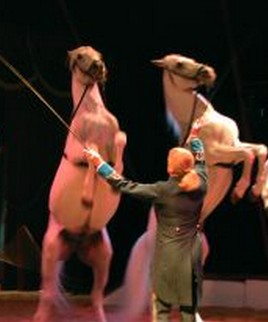About Lipizzaner Horses
by Adrianne Lake
Lipizzaner Horse Breed Description:
Lipizzaners are considered horses of royal beauty and elegance. This breed is world famous for their performances on tour and at the Spanish Riding School of Vienna. They have been called “Pegasus” horses without wings. The Lipizzaners were originally bred for battle, yet excel in the equine ballet of high school dressage. These horses have inspired and warmed people’s hearts for hundreds of years with their charming piaffes, passages and pirouettes. These horses look as if they are “walking on air” and are unrivaled in their mystical dressage movements.
Lipizzaners are almost always grey (they look white but are technically classified as “grey” because of their black skin). Foals are born either dark black, grey or bay and lighten with age. Because of the Karst blood, these horse stop growing at about seven and aren’t fully mature until about 10 years old. Lipizzaners are said to go through a pronounced “ugly duckling” stage when they are young.
This breed is 15 – 16 HH in height and has a compact muscular body with a long back and arched neck. The tail on the Lipizzaner is silky, highly set and well carried. They have very good quality feet and a deep girth for their heart and lungs. Their heads resemble the Arabians yet the Spanish influence is most obvious. The breed of Lipizzaners is long-lived and very hardy (thanks to Karst and Arab blood) with good bone. They have a very lively gait with high hock and knee action. Different distinct physical characteristics can be seen in different bloodlines. These characteristics were so pronounced in the six founding stallions that they can be recognized in Lipizzaners today.
Their regal looks match their personality. Lipizzaners are highly intelligent, kind and willing horses. The magnificent stallions are said to be very docile creatures and easy to handle and train. These are very special animals.
Lipizzaners obtain their names in a unique way. If a colt is born it is named two names: one is his sire’s name and the other his dam’s name. A filly is named after her dam. Numerals are used to indicate the lines of mares. For example let us say a mare called Lippi XI was bred to a stallion called Zanner. If the foal was a colt his name would be Zanner Lippy XI. If the foal was a filly she would be called Lippi XII. Brands are also used on Lipizzaners to distinguish between stud farms.
Breed History:
The Lipizzaner horses have had a checkered past and their true story of survival in WWII is portrayed in Walt Disney’s “Miracle of the White Stallions”. This breed has triumphed (against the odds) over war, famine, and other disasters. Lipizzaners are now found in Europe, Australia, and North America. These horses are rare and hard to come by yet they are cherished and protected. Ancestry of the Lipizzaner horses can be traced back as far as 800 AD. Berber horses were imported to Spain from North Africa and bred with Karst horses by the Moors. The Karst horses were small, white, long-lived, very hardy and slow to mature. The Romans used them in battle and sports such as chariot racing.
Archduke Charles II took it upon himself to provide horses the likes of which the Austrian court had never seen. In 1580 he created a studfarm named “Lipizza” (later called Lipica) in what is now Yugoslavia. This is where the term “Lipizzaner” originates. Nine stallions and 24 mares of Spanish blood were bred to only the finest Karst horses. These imported horses were Andalusian descendents of the Berber and Karst horses bred by the Moors. Spanish horses were imported to the Lipica Studfarm until the 17th Century hence the name “Spanish Riding School”. Pure Arabian blood also infused the bloodlines of these horses. There are six founding stallions of the Lipizzaner breed. Their distinct characteristics can clearly be seen in the Lipizzaners of today.
The Lipizzaner Founding Stallions include:
- Pluto who was a grey Spanish stallion foaled in 1765.
- Neapolitano who was a black horse foaled in 1790. He was a Neapolitan.
- Favory was a dun coloured horse born in 1779 and from the Austrian Court Stud.
- Maestro was grey coloured, also from the Austrian Court Stud and was born in 1773.
- Siglavy was a grey Arabian from Arabia foaled in 1810.
- Conversano was an original black Neapolitan born in 1767.
And so the famous Lipizzaner horse was created. As mentioned earlier, this breed has survived both World Wars and many revolutions. The Lipizzaners had to be evacuated from their current locations numerous times. They have also survived food shortages and an earthquake. At times their numbers have dwindled below 200 horses in the world. In 1920 the Studfarm was moved to “Piber” which is located in Styria of Lower Austria. Today all the horses at the Spanish Riding School in Vienna come from the Austrian State Stud. 400 years of very selective breeding and intense, careful training has produced these wonderful dancing white horses. Until the 18th Century, Lipizzaners came in all coat colours. Now the vast majority of them are grey although is traditional to have at least one bay stallion in residence at the Spanish Riding School in Vienna. Although primarily used for its trademark high school dressage, Lipizzaners are good at driving and have been used for light draft work.

